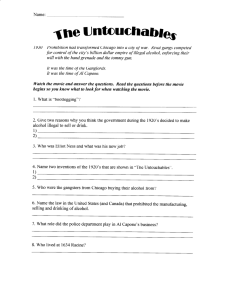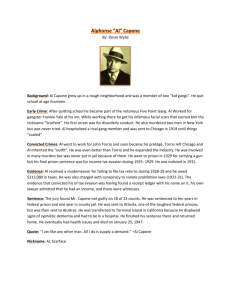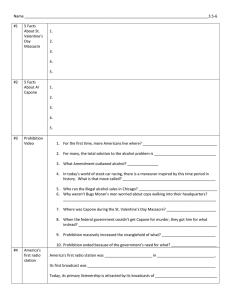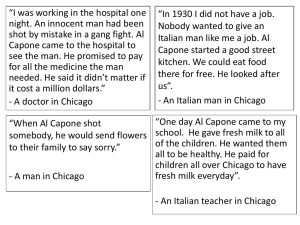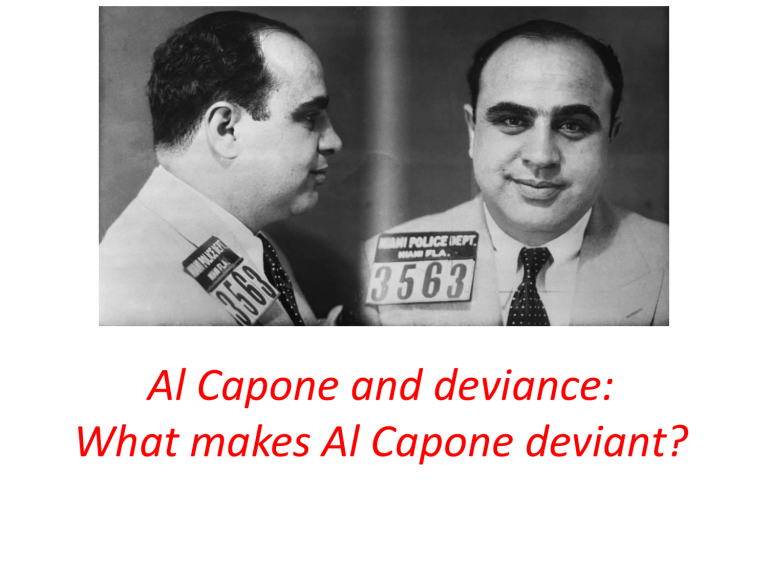
Al Capone and deviance: What makes Al Capone deviant? Reseach Paper Question: What makes Al Capone deviant? Gangsterism, in general, was originally sensationalized to provide the American public in the economic climate of the Great Depression an entertaining escape from the harsh realities of everyday experiences. Al Capone, also known as Scarface, was one of the gansters of the Chicago mafia during the Prohibition era. He captured the public imagination, and was admired by many individuals due to his actions. However, his actions included illegal activites that led him to be stigmatized as ‘deviant’. Deviance and Al Capone Even though the mobster type of gangster such as Capone was violent, he successfully managed to bootleg* alcohol with great success, which led much of the people of America (in 1930s) to embrace him. He was evaluated positively, meaning that social reactions towards him were mostly positive. In 1930s, many gangsters, including Al Capone, were worshipped and admired by many individuals, yet most people would say that these gangsters were deviants. HOWEVER, just because the majority of a given group regards a behavior (or condition) as ‘unacceptable’ does not automatically make that behavior (or condition) ‘deviant.’ * bootlegging: illegal alcohol trade Why did I choose this topic? Deviance is an interesting topic to work on. ↓ This topic provides me with certain perspectives about gangsterism, especially Al Capone. ↓ Gangsterism, in general, can directly be associated with our course theme: Deviance. ↓ Gangsterism can be analyzed within the frame of both deviance admiration and negative deviance. Thesis Statement Al Capone, as a gangster of 1930s, can be considered deviant for several reasons. He revolted against social norms, he used illegal means which range from bootlegging to extortion to become stronger for his own good, and he promoted violence during his reign. Basic plan of my research paper Introduction (Al Capone’s background) + Thesis Statement First of all, I would like to explain what the gangsterism is, how it evolved in America (where Al Capone lived), its’ correlation with deviance, and impacts on the society. Secondly, I would like to introduce how Al Capone was influenced by other gangsters, including Johnny Torrio, his involvement in gangs, and his illegal activities that are associated with deviance. Lastly, I would like to answer such questions in order to analyze him, and of course his deviance-related actions: How did people of 1930s perceive Al Capone and his actions? What is the relationship between his actions and deviant behavior? Were his actions, as a gangster, completely deviant? What would have been his actions that eliminate the risk of being labeled as deviant by the society? … Conclusion Heckert & Heckert Conflict Theory ??? Source 1 → Chicago: Shades of Capone Virgil W. Peterson Peterson, V. W. (1963). Chicago: Shades of Capone. The ANNALS of the American → Academy of Political and Social Science, 347(1), 30–39. https://doi.org/10.1177/00027162633470 0105 It mainly talks about the Development of Capone Organization. It is a promising source for me to analyze his impacts on various areas, and how he invaded the field of finance, food business, automobile sales, and the coin-machine industry. While analyzing his impacts on different areas, I can link his actions with deviant behaviors. It is a reliable source as it was written by Virgil Peterson, who is the Operating Director of the Chicago Crime Commission. Source 2 → The Gangster in Our Midst: Al Capone in South Florida Stephen C. Bousquet Bousquet, S. (1998). The Gangster in Our Midst: Al Capone in South Florida, 1930→ 1947. The Florida Historical Quarterly, 76(3), 297-309. Retrieved from http://www.jstor.org/stable/30148969 This source gives historical background about Al Capone. Moreover, some of the incidents in Al Capone’s life are provided. This source also compares the modern gangs with the gangs of the Capone era. Thus, it is a useful source that might help me to give current examples in order to compare and demonstrate the deviance level of Al Capone (by relying on his life). This source is written by Steve Bousquet. He is a reporter, which makes this publication reliable by relying on his observations. Source 3 → Al Capone and the Calder, J.D. (1992). Al Capone and the Internal Revenue Service: State-sanctioned Internal Revenue criminology of organized crime Service: State→ Reterieved from sanctioned https://doi.org/10.1007/BF00190169 criminology of organized crime James D. Calder This is an excellent article demonstating public’s opinion regarding Al Capone’s life from the government’s perspective. However, in this source, it is highlighted that a well-documented history of Capone's conflict with the federal government has not been written. Interestingly, such a history could not be written until all the documents related to Capone’s records have been gathered and reviewed. Dr. Calder has been a faculty member at UTSA since 1979, teaching and publishing first as a member of the Department of Criminal Justice until 2006. His studies on criminal activities provide accuracy. Source 4 Prohibition Gangsters The Rise and Fall of → a Bad Generation Marc Mappen → Mappen, M. (2013). Prohibition gangsters: The rise and fall of a bad generation. New Brunswick, N.J: Rutgers University Press. Based on government files and FBI files, this book provides a narrative of almost all the activities of 1920s, the Depression of the 1930s, and beyond. In this book, there are two specific parts that mainly talk about how the Prohibition generation, Al Capone and others, transformed organized crime from loosely associated gangs of the pre-Prohibition era into sophisticated, complex ones. It is a quite understandable book written by Marc Mappen. Dr. Marc Mappen has been described by the New York Times as ‘the eminent New Jersey historian’, he has seven books to his credit, including the award-winning Encyclopedia of New Jersey. Problems that I anticipate Which order should I follow? ↓ Definition of gangsterism and its evolvement, following Al Capone’s background OR Al Capone’s background and definition of gangsterism and its evolvement Which theories should I use? 1. Heckert & Heckert (a new typology of deviance: integrating normative and reactivist definitions of deviance) 2. Conflict Theory (by Marx and Weber) 3. ???
